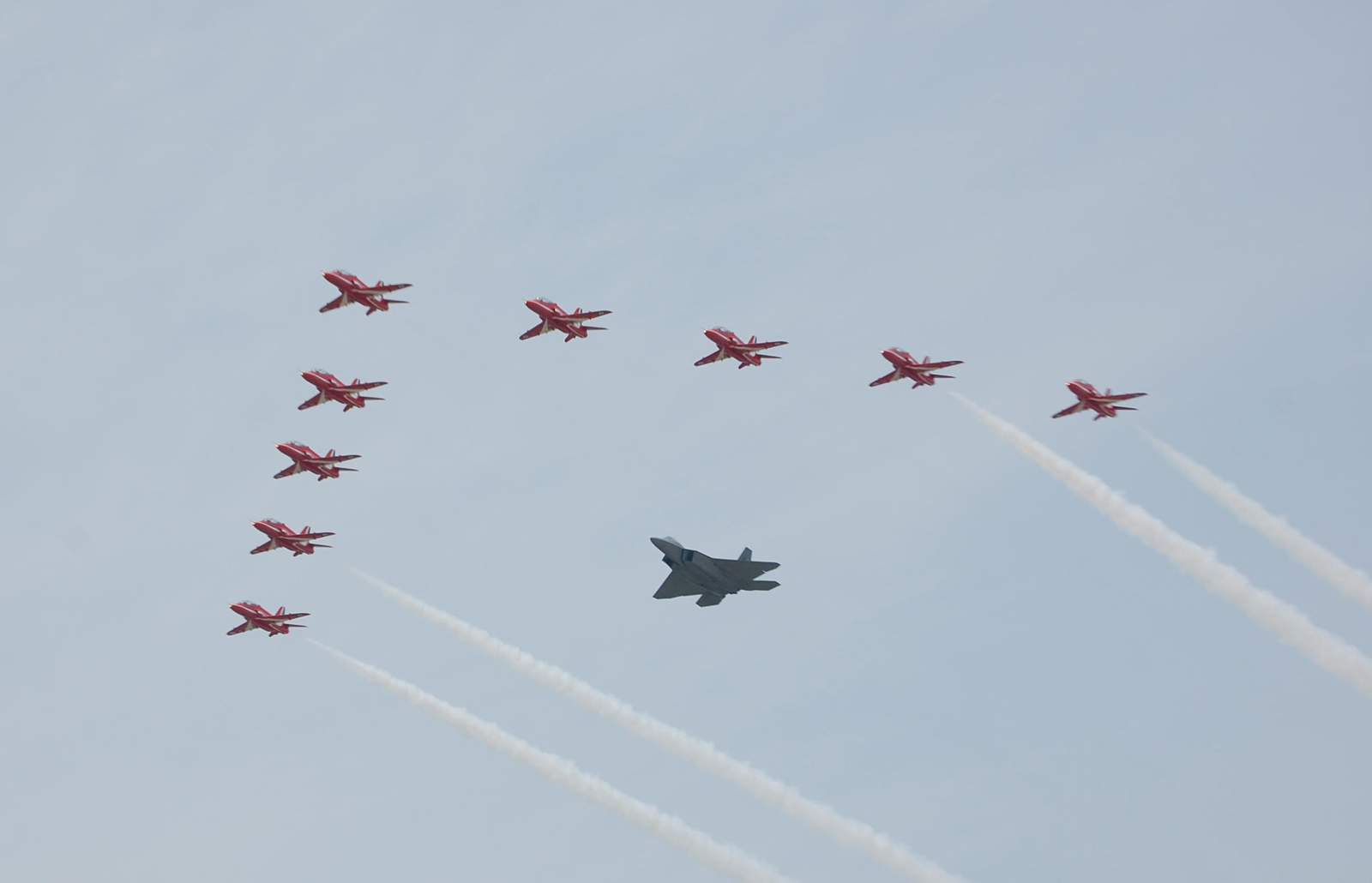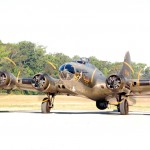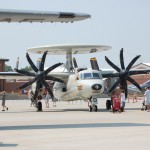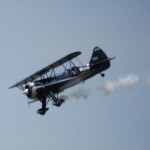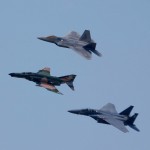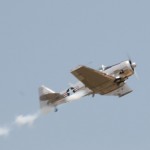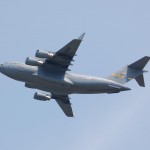By Henry M. Holden

Maj. Paul Moga flies in formation in an F-22 Raptor with the Royal Air Force Aerobatic Team, the Red Arrows.
Jet plane junkies weren’t the only happy folks on the tarmac at Langley Air Force Base’s (LFI) long-running annual AirPower over Hampton Roads, held June 20-23 in Hampton, Va. Vintage props such as the North American P-51 Mustang, a Mitchell B-25 bomber, a British Spitfire and Hurricane were among the aircraft that thrilled the round-engine folks.
As the host unit, the 1st Fighter Wing operates and maintains one of the largest fighter bases in Air Combat Command. The air show/Air Force open house originated in the 1920s. The free event’s variety of aerial acts and displays allowed the 185,000 visitors an up-close look at the U.S. Air Force.
On Friday night, the show began at 5 p.m., featuring an after-dark air show starring Matt Younkin and his Beech 18, a concert by Pat Green and fireworks. The main air show took place on Saturday and Sunday.
Visitors come to the open house expecting a wide array of entertainment, from civilian aerobatics to military demonstrations, and this year exceeded their expectations. The show included performances from the Royal Air Force Red Arrows, Team Vortex, Bill Leff and his T-6 Texan, E Team Skydivers, The USAF Reserve’s Ed Hamill, GEICO Skytypers, Sons of Legends, Embry Riddle’s Matt Chapman and an Air Force Heritage Flight.

Sean Carroll and his Yak 9 kicked off the day. Carroll had to push his plane to 360 mph to qualify for the Reno Air Races, and it looked like he was close to that during his performance.
Twenty-three static aircraft displays were also available on the ground for photo opportunities, and children of all ages had opportunities to tour some of the latest Air Force aircraft.
Immediately after the E Team Skydivers opened the show with the national anthem and delivered the flag from above, Sean Carroll and his YAK 9 kicked off the day. Carroll, the founder of the YAK Demonstration Team, is one of the highest-time YAK pilots in the country.
An F-22 Raptor, flown by Maj. Paul “Max” Moga, performed a variety of aerial maneuvers, including the “Mongo Flip,” “J Turn” and “Pedal Turn.” Moga also demonstrated the unprecedented agility of the Raptor, in a high-speed fly-by at almost 700 miles per hour, just under the speed of sound, followed by punching a hole in the sky with a full afterburner climb and high G turn, showcasing the aircraft’s unmatched war fighting capabilities.
For more than 30 years, the late Jimmy Franklin and Bobby Younkin brought innovative, and sometimes insane, acts to life with their extraordinary flying ability. Keeping their tradition alive are Kyle Franklin and Matt Younkin, the sons of the legends, both third-generation pilots, and less than a year apart in age. Air shows have been a part of their lives since they were born, and they’re showing the world that they have what Younkin used to call “that defective gene.”

Sponsored by the Disabled American Veterans Air Show Outreach Program, Panchito gave a 20-minute demonstration of World War II low-level bombing.
Since 1999, Kyle Franklin has been flying the Waco Mystery Ship his father was well-known for piloting (before the jet-powered Waco). Built in 1940, this unique Waco has been through several modifications throughout the years. It no longer looks like an original Waco, hence the name “Waco Mystery Ship.”
The Waco Mystery Ship is one of the few remaining big biplane aerobatic acts found on the air show circuit. A full complement of loops, rolls, Cuban 8s and hammer heads make up Franklin’s performance; he’s one of a handful of pilots who will torque roll, tail slide and even lomcevak his enormous Waco.
The lomcevak, a Czech word meaning “headache or hangover,” is particularly dramatic. Franklin starts out at 4,000 feet and lets the plane tumble nose over tail into an inverted flat spin, recovering just short of the ground. This stunt is a heart-stopping moment, and never fails to thrill spectators with its spine-chilling danger.
Matt Younkin’s Beech 18 performance is perhaps one of the most unusual acts on the air show circuit today. It’s almost a mirror image of the one his father pioneered and flew for more than 15 years. Although not designed for aerobatic flight, the Beech 18 begins with a roll on takeoff followed by a series of Cuban 8s, point rolls and a loop. The conclusion is a dirty pass dubbed the “Elephant Waltz,” in which Matt rocks the huge airframe’s wings more than 90 degrees with the landing gear and flaps extended.
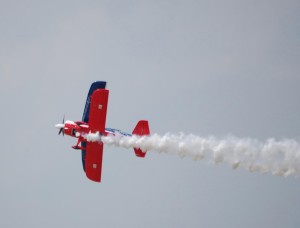
Ed Hamill has been entertaining air show crowds since 1999. His unique air show tells a story he calls “Living the Dream.” This year marks the sixth consecutive year Hamill and his team operated as the Air Force Reserve Biplane Show.
In his Dream Machine Air Force Reserve Biplane Show, Ed Hamill dived and rolled through three different acts: barnstorming, aerobatic competition and his sky dancing routine.
“The highest I fly is about 1,800 feet, which happens at the top of the torque roll; from that point, I essentially fly backwards at a speed of about 50 mph,” said Maj. Hamill, an F-16 instructor in the Air Force Reserve. “The difference between flying a jet and the biplane is extraordinary. The on-board computers in the F-16 free the pilot for other tasks, but the biplane is strictly hands-on flying.”
He said constant practice is the only way to fly a safe air show.
“I always tell kids to set goals, work hard and never give up,” he said. “Hard work is definitely an essential ingredient in that equation. Practice is one of the best ways of preparing for the unexpected.”
Team Vortex’ Maj. Ken “K9” Appezzato took his Eagle through heart-stopping “powerbatics.” The airplane is a one-of-a-kind prototype combination Pitts S2 and Christen Eagle, powered by a 540-ci, 300-hp Lycoming 540 engine capable of 240 mph and +/- 9 G’s.
For Bill Leff’s routine, he does about 15 minutes of low-level aerobatics, pushing his AT-6 Texan, restored in authentic Korean War markings, to 200 mph and winding it down to 60 mph. Leff’s energy management routine pushes the stock T-6 beyond the normal flight envelope. He dedicates each of his performances to veterans of the military services.
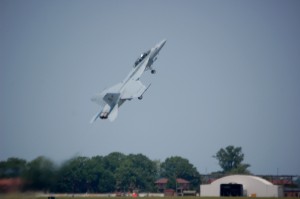
Capt. Phillip A. “Ritz” Smith, an Air Force F-15E demonstration pilot, showcases the F-15E with Capt. Ed “Wild” Colfer, the Air Combat Command’s Strike Eagle F-15E Demonstration Team weapons system officer.
One of two B-25 medium bombers sponsored by the Disabled American Veterans Air Show Outreach Program, Panchito gave a 20-minute demonstration of World War II low-level bombing. Named after the feisty rooster from Disney’s animated musical, “The Three Caballeros,” Panchito saw combat with the 396th Bomb Squadron, 41st Bomb Group, 7th Air Force, stationed in the Central Pacific. After several attacks on various strongholds in southern Japan, as well as Japanese-held eastern China, Panchito was ready for another bombing run to Japan on the day the Japanese surrendered.
Established in 1997, the U.S. Air Force Heritage Flight program commemorated the Air Force’s 50th anniversary. Since then, it has continued each year with today’s state-of-the-art fighters flying in close formation with warbirds from earlier generations. In a moving tribute, the Air Force put its best fighter aircraft, the F-22 Raptor, in formation with its Vietnam F-4 Phantom and Iraq War F-15 Strike Eagle veterans.
This year, the Thunderbirds were unable to appear due to some schedule changes, but the 1st Fighter Wing was able to call in the Royal Air Force Red Arrows for the closing act. The Red Arrows are renowned throughout the world as ambassadors for both the Royal Air Force and the United Kingdom. This was the Red Arrows’ first time flying in the U.S. since 1993, with the team starting its tour at Langley.
Opening the Red Arrow’s segment were the E Team Skydivers, who carried the British flag down to the accompaniment of the British national anthem. The display team includes nine Hawker T1 advanced-training aircraft flown by pilots from frontline Royal Air Force squadrons. The pilots perform a symmetrical diamond formation as their trademark. The team, officially formed in 1965, has completed more than 4,000 displays in 53 countries.
For more information, visit [http://www.langleyafbairshow.com].
- The B-17, Memphis Belle, remained on static display this year but still drew large crowds. Here, it’s departing Virginia Beach Airport (45VA) for the short hop to Langley Air Force Base.
- The B-1B Lancer is a multirole supersonic aircraft capable of long-range bombing and missile launching with nuclear weapons.
- The A-10 Warthog is an effective tank killer and ground support aircraft.
- The eight-bladed props of a Navy E-2 Hawkeye were a constant attraction later in the day.
- As he taxis in, Matt Younkin’s Beech 18 trails environmentally friendly smoke.
- Kyle Franklin, son of legendary pilot Jimmy Franklin, has been flying his father’s original Waco Mystery Ship since 1999.
- The Air Force Heritage Flight consisted of, top to bottom, the F-22 Raptor, F-4 Phantom and F-15E Strike Eagle.
- Bill Leff flew his T-6 Texan through 15 minutes of low-level aerobatics, including barrel rolls, inverted flight, loops, four-point rolls and Cuban 8s.
- Three of the six GEICO Skytypers take off in their vintage WWII SNJ-2 airplanes.
- The C-17 Globemaster does a fly-by before departing the area.











